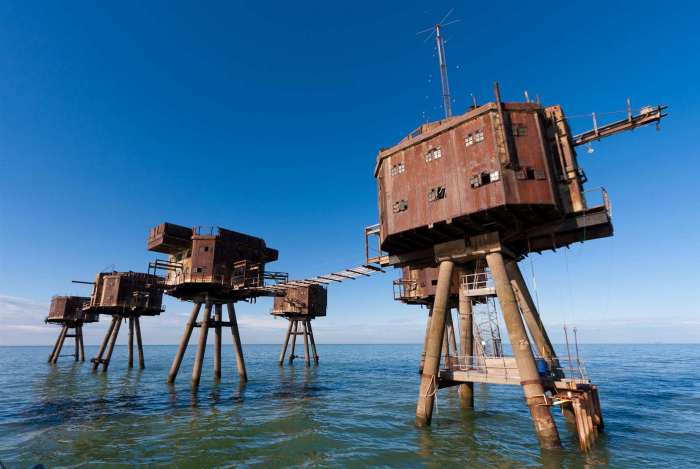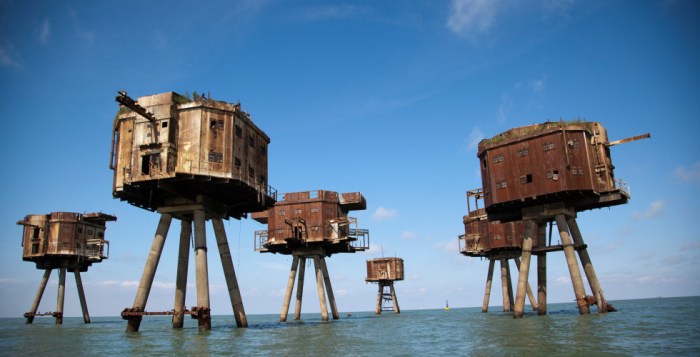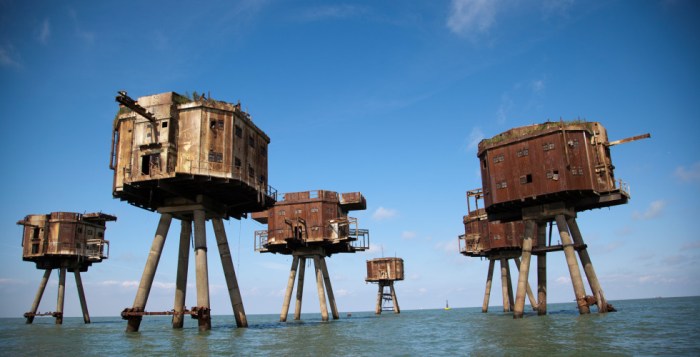The Maunsell Forts Whitstable, also known as the Red Sands Forts, stand as iconic structures off the coast of Kent, England. These former military installations played a crucial role in Britain’s coastal defense during World War II and the Cold War.
Their unique design and historical significance make them a fascinating subject for exploration.
Built between 1942 and 1943, the Maunsell Forts were designed to protect the Thames Estuary and London from German air and sea attacks. These innovative structures consisted of seven steel platforms supported by concrete towers, each equipped with anti-aircraft guns, radar systems, and living quarters for the personnel stationed there.
Historical Significance
The Maunsell Forts were a series of seven fortified towers built in the Thames Estuary during World War II to defend the United Kingdom from German air and sea attacks. The forts were named after Guy Maunsell, the engineer who designed them.
The forts were constructed on sandbanks and were designed to be unsinkable.
Role in World War II
During World War II, the Maunsell Forts played a vital role in the defense of the Thames Estuary. The forts were armed with anti-aircraft guns and searchlights, and they were used to protect shipping and the port of London from German air attacks.
The forts also served as radar stations, and they were used to track German aircraft and ships.
Role in the Cold War
After World War II, the Maunsell Forts were used as radar stations during the Cold War. The forts were also used to monitor Soviet shipping and aircraft. The forts were decommissioned in the 1950s, and they were sold to private companies.
Design and Construction
The Maunsell Forts were remarkable structures designed to withstand extreme conditions and serve as offshore platforms for military operations. Their unique design and construction employed innovative engineering techniques and materials.
The forts consisted of two main types: Army Forts and Naval Forts. Army Forts were smaller and primarily intended for anti-aircraft defense, while Naval Forts were larger and equipped with heavy guns for coastal defense. Both types featured a central steel tower supported by seven steel legs.
Materials and Dimensions
- Steel:The forts were constructed using high-tensile steel, which provided strength and durability in the harsh marine environment.
- Concrete:The legs and base of the forts were encased in concrete, providing stability and protection against erosion.
- Dimensions:The Army Forts measured approximately 25 meters (82 feet) in height and 12 meters (39 feet) in diameter, while the Naval Forts were larger, measuring 35 meters (115 feet) in height and 18 meters (59 feet) in diameter.
Structural Features
- Leg Design:The seven legs of the forts were arranged in a radial pattern, providing a stable base and minimizing the impact of waves and currents.
- Central Tower:The central tower housed living quarters, command centers, and other essential facilities for the personnel stationed on the fort.
- Deck Structure:The deck of the forts provided a platform for weapons, radar equipment, and other operational systems.
- Mooring System:The forts were anchored to the seabed using a complex mooring system that included chains and anchors, ensuring stability in strong winds and rough seas.
Armament and Defenses

The Maunsell Forts were equipped with an array of defensive systems and armament to deter enemy attacks and defend the Thames Estuary. The forts were armed with a combination of anti-aircraft guns, searchlights, and radar systems.
Anti-Aircraft Guns
The primary armament of the Maunsell Forts consisted of anti-aircraft guns. These guns were designed to engage and destroy enemy aircraft approaching the estuary. The forts were equipped with various types of anti-aircraft guns, including:
- 3.7-inch (94 mm) QF guns: These guns were capable of firing high-explosive shells to a maximum altitude of 10,000 feet (3,000 m).
- 4.5-inch (114 mm) QF guns: These guns had a longer range and higher rate of fire than the 3.7-inch guns, and could reach altitudes of up to 15,000 feet (4,600 m).
- 5.25-inch (133 mm) QF guns: These guns were the most powerful anti-aircraft guns installed on the Maunsell Forts, and could engage targets at altitudes of up to 20,000 feet (6,100 m).
Searchlights
In addition to anti-aircraft guns, the Maunsell Forts were also equipped with searchlights to illuminate enemy aircraft at night. These searchlights had a range of up to 10 miles (16 km), and were used to guide the fire of the anti-aircraft guns.
Radar Systems, Maunsell forts whitstable
The Maunsell Forts were also equipped with radar systems to detect and track enemy aircraft approaching the estuary. These radar systems were able to detect aircraft at distances of up to 50 miles (80 km), and provided early warning of potential attacks.
Garrison and Daily Life

The Maunsell Forts were manned by a crew of approximately 200 personnel, including officers, gunners, radar operators, and support staff. The living conditions on the forts were cramped and uncomfortable, with personnel sleeping in hammocks or bunks in small, windowless cabins.
The daily routine on the forts was highly regimented. Personnel would rise early for breakfast, followed by a morning briefing and maintenance checks. The rest of the day was spent on watch duty, training, or other duties. Meals were served in a communal mess hall, and there was a small recreation room where personnel could relax and socialize.
Challenges and Adaptations
The personnel stationed on the Maunsell Forts faced a number of challenges, including isolation, boredom, and the harsh weather conditions. To combat these challenges, the forts were equipped with a variety of amenities, including a library, a cinema, and a gymnasium.
Personnel also organized their own sports and social events to keep themselves entertained.
Post-War Use and Abandonment
After the war, the Maunsell Forts were used for a variety of purposes. Some were converted into radio broadcasting stations, while others were used as navigational aids or for military training. However, as technology advanced, the forts became increasingly obsolete and were eventually abandoned.
Decline and Abandonment
The decline of the Maunsell Forts began in the 1950s, as advances in radar and other technologies made them less necessary for coastal defense. By the 1960s, most of the forts had been decommissioned and were left to deteriorate.In the 1980s, a group of investors purchased several of the forts with the intention of converting them into a luxury resort.
However, the project was never completed, and the forts were once again abandoned.Today, the Maunsell Forts are largely derelict and are considered to be a hazard to navigation. However, they remain a popular tourist destination, and several organizations are working to preserve them.
Conservation and Restoration: Maunsell Forts Whitstable
Efforts to conserve and restore the Maunsell Forts have been ongoing for several decades. The forts’ unique historical significance and architectural value have prompted organizations and individuals to undertake projects aimed at preserving their legacy.One of the key challenges in conserving the Maunsell Forts is their exposed location in the North Sea.
The forts are subjected to harsh weather conditions, including strong winds, high waves, and salt spray. These factors can cause significant damage to the structures over time.Despite these challenges, progress has been made in preserving the Maunsell Forts. In 1996, the forts were designated as Scheduled Monuments, which provides them with legal protection from unauthorized alteration or demolition.
Explore the intriguing Maunsell Forts Whitstable, a series of abandoned military platforms located off the coast of England. For a change of pace, discover the enchanting town of Glastonbury, CT, where you can delve into its rich history and indulge in its charming offerings.
From exploring the iconic Glastonbury Abbey to embarking on scenic hikes, there’s a myriad of things to do in Glastonbury CT . Return to the captivating Maunsell Forts Whitstable, where you can marvel at their unique architecture and immerse yourself in their fascinating history.
Conservation Projects
Several conservation projects have been undertaken to stabilize and repair the forts. In 2003, the Maunsell Fort Society was formed with the mission of preserving and restoring the forts. The society has carried out a range of projects, including:
- Repairing damaged concrete and steelwork
- Installing new roofs and windows
- Cleaning and repainting the structures
In addition to the work of the Maunsell Fort Society, other organizations and individuals have also contributed to the conservation effort. In 2012, a team of volunteers from the University of Kent conducted a survey of the forts to assess their condition and identify areas in need of repair.
Challenges and Progress
The conservation and restoration of the Maunsell Forts is an ongoing process. The forts are exposed to a harsh environment, and the work of preserving them is complex and expensive. However, progress has been made in recent years, and the forts remain an important part of the UK’s maritime heritage.
Tourism and Accessibility
The Maunsell Forts have become popular tourist attractions, offering a unique opportunity to explore their rich history and admire their distinctive architecture.
Visitors can access the forts through guided tours, which typically include a boat trip to the structures and a guided tour of the fort’s interior. Some tours also offer opportunities for overnight stays or special events.
Accessibility
Accessibility to the Maunsell Forts is limited due to their location in the Thames Estuary. Tours are typically offered during favorable weather conditions, and visitors should be prepared for potential delays or cancellations due to adverse weather.
The boat trips to the forts can be challenging for individuals with mobility impairments or those prone to seasickness. Visitors should consider these factors before booking a tour.
Once on the forts, there are limited facilities available. Visitors should bring their own food and drinks, as there are no food or beverage services on the forts.
Cultural Impact
The Maunsell Forts have become iconic symbols of the Second World War and have captured the public’s imagination. They have been featured in numerous films, television shows, and works of literature, and have inspired artists and musicians.
Representation in Popular Culture
The forts have been featured in films such as “The Dambusters” (1955), “Sink the Bismarck!” (1960), and “Dunkirk” (2017). They have also appeared in television shows such as “Doctor Who” (1963-present) and “The Crown” (2016-present). In literature, the forts have been featured in novels such as “The Guns of Navarone” (1957) by Alistair MacLean and “The Eagle Has Landed” (1975) by Jack Higgins.The
forts have also inspired artists and musicians. The British artist J.M.W. Turner painted a series of watercolors of the forts in the 1840s. The British musician David Bowie recorded a song called “The Man Who Sold the World” (1970) which was inspired by the forts.
Comparison to Other Sea Forts
The Maunsell Forts share similarities with other sea forts constructed around the world, serving defensive purposes and adapting to evolving military technologies. However, they also exhibit unique characteristics that distinguish them from their counterparts.
One notable similarity lies in the forts’ primary function as defensive structures. Like other sea forts, the Maunsell Forts were designed to protect coastal areas and naval installations from potential attacks. They served as platforms for anti-aircraft guns, radar equipment, and searchlights, providing early warning and defensive capabilities against enemy aircraft and ships.
Design and Construction
In terms of design and construction, the Maunsell Forts differ from many other sea forts. While some sea forts were built on natural or artificial islands, the Maunsell Forts were constructed on steel platforms supported by concrete legs. This unique design allowed them to be deployed in deeper waters, providing a stable base for operations even in rough seas.
Armament and Defenses
The armament and defenses of the Maunsell Forts also varied compared to other sea forts. While many forts relied on heavy artillery and machine guns, the Maunsell Forts were equipped with a combination of anti-aircraft guns, radar, and searchlights. This armament mix reflected the evolving nature of warfare during World War II, with an emphasis on aerial combat and electronic warfare.
Historical Significance
The historical significance of the Maunsell Forts is intertwined with their role in World War II. They played a crucial role in defending the Thames Estuary and the Port of London from German air raids. Their successful operation contributed to the Allied victory in the Battle of Britain and earned them a place in British maritime history.
Post-War Use and Abandonment
After World War II, the Maunsell Forts were decommissioned and abandoned. Unlike some other sea forts that were converted for civilian use or preserved as historical landmarks, the Maunsell Forts fell into disrepair and were left to the elements. Their abandonment contributed to their unique and evocative appearance, attracting attention from artists, photographers, and urban explorers.
Environmental Impact
The Maunsell Forts had a significant environmental impact on the surrounding marine ecosystem during their construction, abandonment, and potential restoration.ConstructionThe construction of the forts involved the placement of large concrete structures on the seabed, which disturbed the natural habitat of marine life.
The dredging and piling operations also released sediments and pollutants into the water, potentially harming marine organisms.
Abandonment
After the forts were abandoned, they became artificial reefs, providing a habitat for various marine species. However, the presence of hazardous materials, such as asbestos and lead paint, posed risks to marine life and the ecosystem.
Potential Restoration
Efforts to restore the forts for conservation or tourism purposes must consider the potential environmental impact. Restoring the forts may involve removing hazardous materials and stabilizing the structures, which could disrupt the established marine ecosystem. Additionally, increased human activity around the forts could impact marine life behavior and habitat.
Future Plans and Potential Uses
The Maunsell Forts’ unique history and location have sparked interest in their potential for adaptive reuse and development.
Several plans have been proposed to transform the forts into:
Conservation and Adaptive Reuse
- Museums and heritage centers showcasing the forts’ military and maritime significance.
- Art and cultural installations, offering a unique backdrop for exhibitions and performances.
- Research and educational facilities, supporting marine biology, environmental monitoring, and sustainable development.
Tourism and Hospitality
- Luxury accommodations, providing exclusive retreats with panoramic views.
- Adventure tourism destinations, offering activities like diving, snorkeling, and guided tours.
- Event spaces, hosting weddings, corporate retreats, and private functions.
Outcome Summary
Today, the Maunsell Forts Whitstable serve as a testament to the ingenuity and determination of the British people during wartime. Their unique design and historical significance have made them a popular tourist destination, offering visitors a glimpse into a bygone era of coastal defense.
FAQ Insights
What was the purpose of the Maunsell Forts Whitstable?
The Maunsell Forts Whitstable were built to protect the Thames Estuary and London from German air and sea attacks during World War II.
How many Maunsell Forts were there?
There were seven Maunsell Forts built in the Thames Estuary.
Are the Maunsell Forts still in use?
No, the Maunsell Forts are no longer in use as military installations. Some of them have been converted into tourist attractions.



